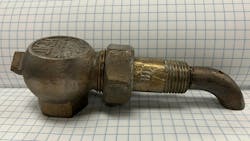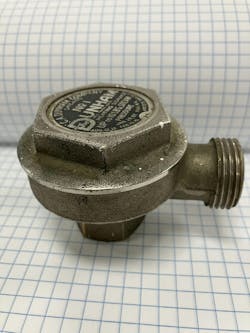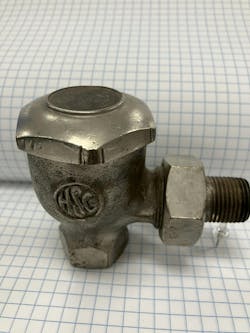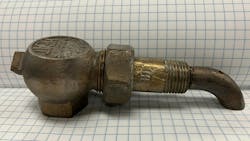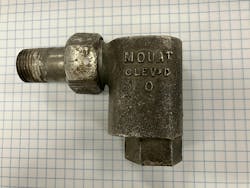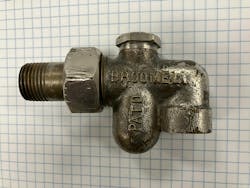Things at the End of a (Two-Pipe Steam) Radiator
We covered a lot of ground last month, but only regarding the one-pipe steam radiator. Who knew there were so many different ways to allow the air to vent out so the steam can flow in? (And I probably forgot to mention something.)
This month, I will attempt to shed some clarity on the things you will find on the side opposite the steam supply valve on a two-pipe radiator. But first, let’s think in terms of steam up—air out—water back.
Steam Up
The first of the two pipes is the supply of steam to the radiator (steam up). Unlike the one-pipe steam connection, which has steam flowing into the radiator while the condensate flows back out of the radiator, this connection only has steam flowing into the radiator.
Since it is a one-way situation, the valve will be a lot smaller. In some very old two-pipe systems, the valve was located at the bottom of the radiator. That was back before the radiator sections were connected at the bottom and the top. On some of those very old systems with the valve at the bottom, you will find a valve on the other side, and an automatic air vent.
The steam flows in the one side, the air passes out through the vent, and the condensate has a direct connection to the wet return form the other side. The water seal of the wet return acts to keep steam in the radiator and out of the return mains. The disadvantages were all those direct connections from upper-level radiators and the vents.
In the more modern systems, the second pipe is for removing both the air and the condensate. Now the steam connection feeds into the top of the radiator. Since steam is lighter than air, the steam starts pushing the air to the thing on the other side that is connected at the bottom of the radiator. The air passes to the dry return and is released by an automatic air vent at the end of the dry return.
The steam condenses on the insides of the radiator and flows down to the thing on the other side. It now passes through the same connection as the air to the dry return. The dry return connects vertically to the wet return, returning the water to the boiler to be heated to the temperature of steam.
Air Out
American industry developed a lot of different things for the return side of the two-pipe radiator from the early part of the 1900’s to about 1930. They all passed air (air out) and condensate (water back), but some also automatically closed at the presence of steam. We call that a radiator trap. See photos 1 and 2.
We don’t want the steam to get to the dry return, which two-pipe radiators are connected to. Steam in the dry return complicates our lives with uneven heat and water hammer.
The steam trap stays open at the beginning of a cycle to allow the air to be pushed out, then closes at the temperature of steam. The condensate then cools the trap enough to open, allowing it to pass the water, then the trap closes again at the temperature of steam.
On a cold night, this silent cycling continues until the thermostat is satisfied. On a mild day, the steam may not get to the trap before the thermostat is satisfied. A half full radiator can heat a room in cool weather.
Over time, the moving part of the radiator trap will fail or it will clog. If it clogs, the radiator goes cold and gets attention. If it fails open, the steam can get to the dry return to cause problems. Repair parts or new traps are available to restore proper operation.
Vapor Systems
Sometimes the thing is not a trap, but operates on the idea of very low pressure and regulated steam flow at the radiator valve. These systems are referred to as vapor systems, operating around eight ounces of pressure. The thing on the end may look like a regular pipe fitting—since it does not have any moving parts—or it can be brand specific. See photos 3, 4 and 5.
The steam does not have to be trapped, because the radiator valve has an internal adjustment to allow a fixed amount of steam into the radiator which is equal to or less than the size of the radiator. Sometimes it was an orifice installed in the valve’s union with a specific size hole, again corresponding to the size of the radiator. Any steam entering the radiator should condense to water before it reaches the other side of the radiator.
Occasionally that thing with no moving parts will clog up and prevent the radiator from heating, but what can screw up this type of system is changing the radiator valve. A new valve in the wide-open position will allow too much steam into the radiator, which allows steam to get to the dry return to complicate our lives. To solve, close valve completely, slightly open, then tell homeowner to leave alone.
Unique Systems
There were many manufacturers in the steam heating business and there were many ways to design the home heating system around the components they produced. To list and explain every different system/component configuration would take years.
If the system doesn’t work, start with the path of steam—sometimes it’s as easy as cleaning the boiler waterline. If the system needs improvement, start with the path of air—sometimes it’s as easy as adding air vents. If the system is noisy, start with the path of the water—usually it’s a clogged wet return.
Patrick Linhardt is a forty-year veteran of the wholesale side of the hydronic industry who has been designing and troubleshooting steam and hot water heating systems, pumps and controls on an almost daily basis. An educator and author, he is currently Hydronic Manager at the Corken Steel Products Co.
About the Author
Patrick Linhardt
Patrick Linhardt is a forty-one-year veteran of the wholesale side of the hydronic industry who has been designing and troubleshooting steam and hot water heating systems, pumps and controls on an almost daily basis. An educator and author, he is currently Hydronic Manager at the Corken Steel Products Co.
